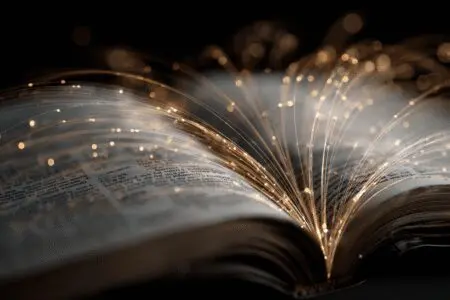Let’s be honest for a second. Staring at a shelf of Bibles can feel overwhelming. You’ve got leather-bound giants, thin paperback ones, Bibles for men, Bibles for women, Bibles for teens… and dozens of different acronyms on the spine. KJV, NIV, ESV, NLT, NASB, CSB. It’s an alphabet soup. I remember my first real Bible, a gift from my grandmother. It was a beautiful, black leather King James Version with crinkly thin pages.
And I honestly couldn’t understand half of it. It felt like trying to read Shakespeare. For a long time, I thought maybe I just wasn’t smart enough. That experience is what started my journey to figure out a simple question: which Bible translation should I read?
If you’re asking that same question, you are in the right place. This isn’t about declaring one translation the “winner.” It’s about giving you the confidence to find the one that’s right for you.
More in Bible Category
Why Are There So Many Bible Translations
What Bible Does the Orthodox Church Use
What Bible Version Is Best for Kids
Key Takeaways Before We Dive In
- There is no single “best” translation for everyone. The best one is the one you will actually read and understand.
- Different translations have different goals. Some try to be as literal as possible, while others focus on readability.
- Using multiple translations can be a great idea. One can be for daily reading, and another for deep study.
- The goal is not just to read words, but to connect with God. Don’t let the search for the “perfect” translation get in the way of that.
Why Are There So Many Bible Versions in the First Place?
This is a great question to ask. It’s not a conspiracy. It really boils down to one simple fact: the Bible wasn’t originally written in English. The Old Testament was written mostly in Hebrew (with a little Aramaic), and the New Testament was written in Greek.
Translating from one language to another is a tricky business. It’s more of an art than a science.
Think about it like this. How would you translate the Spanish phrase “media naranja“? A literal, word-for-word translation would be “half orange.” That makes no sense in English! But the idea or thought behind the phrase is “my better half” or “soulmate.”
Which translation is better? “Half orange” or “soulmate”?
Well, it depends on your goal. If you’re teaching someone Spanish, “half orange” helps them see how the words work. If you’re trying to communicate the romantic meaning of the phrase, “soulmate” is obviously better.
Bible translators face this same dilemma on every single page. This has led to a spectrum of translation philosophies.
The Bible Translation Spectrum: From Word-for-Word to Thought-for-Thought
The easiest way to understand the differences between translations is to picture a line. On one end, you have the “Word-for-Word” translations. On the other, you have “Thought-for-Thought.”
What are “Word-for-Word” (Formal Equivalence) Translations?
These translations try to stick as closely as possible to the original Hebrew and Greek words and sentence structure. They want to give you the English word that corresponds to the original word.
Pros:
- Excellent for deep, technical study.
- You can see the original sentence structure and word patterns.
- Great for comparing how a specific word is used throughout Scripture.
Cons:
- Can be clunky and hard to read casually.
- Sometimes the meaning gets lost in the literal translation (like our “half orange” example).
- Can sound unnatural in modern English.
I spent a season in my life exclusively using the New American Standard Bible (NASB) for study. It was incredible for seeing the nuts and bolts of the text. But when I tried to read it devotionally, I found myself getting bogged down in the phrasing instead of being captured by the story.
Popular Word-for-Word Bibles:
- New American Standard Bible (NASB): Often considered the most literal, word-for-word translation available. A true workhorse for serious study.
- English Standard Version (ESV): A fantastic blend of accuracy and readability. It holds onto literary beauty while staying very close to the original text. It has become my go-to for a balance of daily reading and study.
- King James Version (KJV): The classic. Its majestic, poetic language has shaped the English language for centuries. However, its archaic language (thees, thous) and use of outdated words can make it very difficult for modern readers.
What are “Thought-for-Thought” (Dynamic Equivalence) Translations?
These translations focus more on the original meaning or thought behind the text. The goal is to make the Bible as clear and readable as possible in natural, modern English. They ask, “What was the author trying to say, and how can we best say that today?”
Pros:
- Very easy to read and understand.
- Great for daily reading, devotional use, and for new believers.
- The message comes through clearly and powerfully.
Cons:
- The translators are doing more of the interpretation work for you.
- You might miss some of the nuances of the original words.
- Less suited for deep, technical word studies.
Popular Thought-for-Thought Bibles:
- New International Version (NIV): By far the most popular English Bible translation. It strikes an excellent balance between accuracy and readability. If you walk into almost any church in America, this is likely the Bible you’ll find in the pews. It’s a wonderful choice for just about anyone.
- New Living Translation (NLT): The NLT is even more focused on readability. It reads like a modern book. I’ve found it to be incredibly powerful for devotional reading, where the goal is to let the truth of the passage wash over you. The story of David and Goliath in the NLT feels like an action-packed novel.
- Christian Standard Bible (CSB): A newer translation that calls its philosophy “Optimal Equivalence.” It aims to find the perfect middle ground, being literal when possible and readable when necessary. It’s quickly becoming a favorite for many.
What About Paraphrases?
On the far end of the spectrum, you have paraphrases. These are not strict translations. They are one person’s restatement of the biblical message into their own words.
The Message (MSG): The most popular paraphrase, by Eugene Peterson. His goal was to bring the vibrant, earthy, and explosive language of the original Greek and Hebrew into a language we speak on the street. It can be an amazing tool for seeing a familiar passage with fresh eyes. I wouldn’t use it as my main study Bible, but reading a Psalm from The Message can be a breathtaking experience.
So, How Do I Actually Choose a Bible?
Okay, the theory is great. But you need to pick one. Let’s get practical. Instead of asking “Which Bible is best?” ask “Which Bible is best for this purpose?”
What is the Best Bible Translation for a New Believer?
If you are just starting your journey of faith, the most important thing is to find a Bible you can understand and enjoy reading. You want to get the big picture of God’s story.
For this, I almost always recommend starting with a thought-for-thought translation.
- New Living Translation (NLT): My top recommendation for a brand new reader. It is so clear and engaging.
- New International Version (NIV): A rock-solid choice that will serve you well for years. It’s a little less conversational than the NLT but still very readable.
My advice: Don’t start with the King James Version. Please. While it is a beautiful and historically significant book, the goal is to fall in love with God’s Word, not to get a headache from archaic language.
Which Bible Translation is Best for In-Depth Study?
When you’re ready to dig deeper, to understand the nuances of the text, that’s when a word-for-word translation really shines. You want a tool that gets you as close to the original as possible.
- English Standard Version (ESV): This is my personal favorite for a study Bible. It’s literal enough for serious study but still reads beautifully.
- New American Standard Bible (NASB): If you want maximum precision and don’t mind a slightly more wooden reading experience, the NASB is the gold standard.
- Christian Standard Bible (CSB): This one is a strong contender, offering a great balance that works for both reading and study.
A great resource for understanding the technical side of translation is the Dallas Theological Seminary’s article on the Bible Translation Spectrum. It gives a bit more academic background to these ideas.
Is the King James Version Still a Good Choice?
This is a sensitive topic for some. The KJV is a masterpiece of English literature. For over 400 years, it was the Bible for the English-speaking world. Many of us grew up with its poetic cadences.
However, the English language has changed significantly since 1611. The KJV contains hundreds of words that are now either obsolete or have completely changed in meaning. For example, the word “suffer” in the KJV often means “to allow,” which is very different from our modern understanding.
If you grew up with the KJV and love it, that’s wonderful. But for most people today, a modern translation will be a much better bridge to understanding God’s Word.
If you love the classic feel of the KJV, you might consider the New King James Version (NKJV). It updates the archaic language while keeping the classic sentence structure and beauty of the original.
How Can I Be Sure I Have the Right Bible?
Here’s the secret: there’s no final exam. The “right” Bible for you might change over time.
I used the NIV for years. Then I switched to the ESV for a season of intense study. Now, I use the ESV on my desk, but I often read from the NLT on my phone app because it helps me focus on the heart of the message.
My advice? Try before you buy.
- Go online. Websites like BibleGateway.com let you read and compare dozens of translations for free.
- Pick a favorite passage. Choose a story or a psalm you know well.
- Read it in 3-4 different translations. Read it in the ESV, NIV, NLT, and maybe even The Message.
- Pay attention to how each one feels. Which one makes the story come alive? Which one is easiest to understand? Which one makes you think?
The translation that connects with you is the right one for you, right now.
The Final Word: Just Start Reading
We can spend weeks researching translation methodologies. We can debate the merits of formal versus dynamic equivalence. And there is a place for that.
But at the end of the day, the Bible isn’t a textbook to be analyzed; it’s a love letter to be read. It is God’s living and active Word.
Don’t get paralyzed by the options.
Pick one.
Start reading.
Let God speak to you through its pages. Whether it’s the ESV, the NIV, the NLT, or another solid translation, the power is in the message, not the medium. The best Bible translation is the one that gets off your shelf and into your heart.
Frequently Asked Questions – Which Bible Translation Should I Read

Is the scholarship behind modern Bible translations trustworthy?
Yes, modern translations like the NIV, ESV, NLT, NASB, and others are produced by large teams of expert scholars who work carefully, prayerfully, and over many years to ensure accuracy and reliability in their translations, drawing from extensive knowledge of the original languages.
How can I choose the right Bible translation for my personal reading or study?
To choose a translation, pray for guidance, try reading the same passages in different versions to see which one feels most comfortable and clear, consider your main goal—whether for deep study or daily devotion—and don’t hesitate to use multiple translations to gain a fuller understanding.
Which Bible translation is best for someone new to reading the Bible?
For beginners, the New Living Translation (NLT) or the New International Version (NIV) are highly recommended because they are designed for easy understanding and are engaging for new readers.
What is the difference between a word-for-word and a thought-for-thought Bible translation?
A word-for-word translation closely matches each original Hebrew or Greek word to an English equivalent, aiming for literal accuracy, while a thought-for-thought translation focuses on conveying the main idea or meaning of a passage in language that is natural and easy to understand in English.
Why are there so many different Bible translations available?
There are many Bible translations because the Bible was originally written in Hebrew, Aramaic, and Greek, and translating these languages into English involves making complex choices to accurately convey meaning, ideas, and style. Different translation teams prioritize different aspects like literal accuracy or readability, resulting in a variety of translations.




